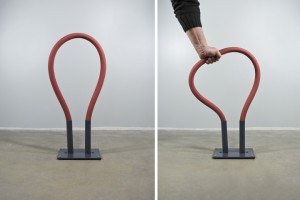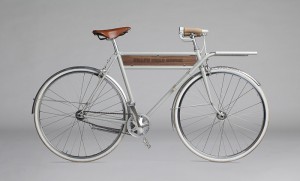 I saw Margus Triibmann’s Tulip Fun Fun bike rack yesterday, and mentioned it on Twitter and Google+ saying, “This is a clever bike rack design. I’d be interested to see how it holds up over time in an urban environment though.” A few people replied with concerns about the security of a flexible bike rack, which is made from steel cable covered with a rubber hose material. I can certainly understand the durability and security concerns, but I really do like the idea behind this design (despite the use of a flimsy cable lock on the top tube in the photos). As the designers’ site points out, “Tulip Fun Fun provides freedom to choose the way and direction of placing the bike. The fixing place of the bike is not uniquely determined hence it is suitable for fixing bikes with different height and different type of frame.” There may be another advantage to the flexible design though. One common way to break a U- lock is to leverage it against the rack using a crowbar, or even with the bike frame itself, until it snaps. As Barry McCauley commented on Google +, this design could render that approach useless. Assuming the steel cable inside is sufficiently thick; I don’t think it would be any easier to saw through than a hollow steel tube either.
I saw Margus Triibmann’s Tulip Fun Fun bike rack yesterday, and mentioned it on Twitter and Google+ saying, “This is a clever bike rack design. I’d be interested to see how it holds up over time in an urban environment though.” A few people replied with concerns about the security of a flexible bike rack, which is made from steel cable covered with a rubber hose material. I can certainly understand the durability and security concerns, but I really do like the idea behind this design (despite the use of a flimsy cable lock on the top tube in the photos). As the designers’ site points out, “Tulip Fun Fun provides freedom to choose the way and direction of placing the bike. The fixing place of the bike is not uniquely determined hence it is suitable for fixing bikes with different height and different type of frame.” There may be another advantage to the flexible design though. One common way to break a U- lock is to leverage it against the rack using a crowbar, or even with the bike frame itself, until it snaps. As Barry McCauley commented on Google +, this design could render that approach useless. Assuming the steel cable inside is sufficiently thick; I don’t think it would be any easier to saw through than a hollow steel tube either.
 Design Milk posted this Columbus steel porteur bike, which was a collaboration between designer, framebuilder, and California College of the Arts professor Nicholas Riddle and San Francisco-based product and graphic design firm Shape Field Office. Overall, the bike looks very nice, and the details are well thought out. I like the use of the triathlon style brake levers to work with the swept back handlebars. The quarter and cork bar plugs on the tubing of the removable front rack are a nice touch too. Check out photos of those details and more on Shape Field’s website.
Design Milk posted this Columbus steel porteur bike, which was a collaboration between designer, framebuilder, and California College of the Arts professor Nicholas Riddle and San Francisco-based product and graphic design firm Shape Field Office. Overall, the bike looks very nice, and the details are well thought out. I like the use of the triathlon style brake levers to work with the swept back handlebars. The quarter and cork bar plugs on the tubing of the removable front rack are a nice touch too. Check out photos of those details and more on Shape Field’s website.

Leave a Reply